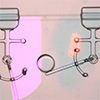Nov 17, 2022 (Nanowerk News) With the help of the high-brilliance X-ray source PETRA III, a German-Swedish research group has developed a new cellulose polymer material that can be specifically animated to move by moisture, making it an ideal base material for programmable actuators. In addition, the composite material is...
Scientists explore electronic materials with nanoscale curved geometries
Nov 17, 2022 (Nanowerk News) In a recently published paper in Nature Electronics ("Electronic materials with nanoscale curved geometries"), an international research group from Italy, Germany, the UK, and China examined significant development directions in the field of electronic materials with curved geometries at the nanoscale. From microelectronic devices with...
Nanoribbons can dramatically improve batteries
Nov 17, 2022 (Nanowerk News) Phosphorene nanoribbons (PNRs) are ribbon-like strands of the 2D material phosphorous, which, like graphene, are made of single-atom-thick layers of atoms. They were first created in 2019 ("Individual 2D phosphorene nanoribbons made for the first time") by a team led by Professor Chris Howard of UCL...
Using electricity to find materials that can learn
Nov 17, 2022 (Nanowerk News) Scientists looking to create a new generation of supercomputers are looking for inspiration from the most complex and energy-efficient computer ever built: the human brain. In some of their initial forays into making brain-inspired computers, researchers are looking at different nonbiological materials whose properties could...
High-performance ceramic nanocoatings do not fatigue
Nov 17, 2022 (Nanowerk News) Extremely thin ceramic coatings can completely change the properties of technical components. Coatings are used, for example, to increase the resistance of metals to heat or corrosion. Coating processes play a role for large turbine blades as well as for extremely stressed tools in production...
Microrobot assembly line (w/video)
Nov 17, 2022 (Nanowerk News) Scientists from the Department of Mechanical Engineering at Osaka University introduced a method for manufacturing complex microrobots driven by chemical energy using in situ integration. By 3D-printing and assembling the mechanical structures and actuators of microrobots inside a microfluidic chip, the resulting microrobots were able...
Smart, cheap ‘Joey’ bot could soon help clear blockages in critical pipes underground
Nov 16, 2022 (Nanowerk News) Beneath our streets lies a maze of pipes, conduits for water, sewage, and gas. Regular inspection of these pipes for leaks, or repair, normally requires these to be dug up. The latter is not only onerous and expensive – with an estimated annual cost of...







